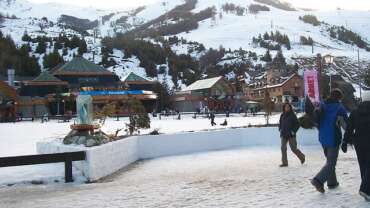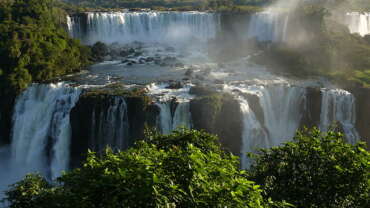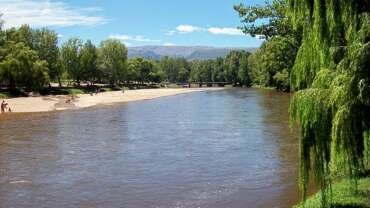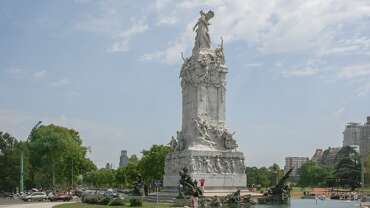Classic City tour of Buenos Aires
With the Obelisco as the starting point, you can walk along the spectacular 9 de Julio Avenue – one of the broadest in the world -, take a picture of the Colon Theater – considered one of the most important opera houses worldwide – and reach the traditional Avenida de Mayo.
Once you reach this classic artery of the city, which was the meeting point of those immigrants who arrived in large amounts to our country during the second half of the 19 th century and the beginning of the 20 th century, the circuit passes by the National Congress, Plaza de Mayo and its surroundings, the Pink House, the Metropolitan Cathedral and the Cabildo (ancient town hall), among others.
History and bohemia in San Telmo, Caminito in La Boca, the elegance of Recoleta (a tour of the Cemetery is recommended), Corrientes (the avenue that never sleeps) or even the Women’s Bridge in the modern district of Puerto Madero, among others, complete the tour. You cannot miss the eclectic architecture of Buenos Aires which is worth analyzing.
Buenos Aires is a classic of all classics, with multiple places to visit and enjoy.
Tango – An icon of Buenos Aires
When the night falls in the city, tango deploys all its sensuous style and charm in the tanguerias, milongas and dinners theaters and high-impact theater shows. The circuit is broad and diverse.
It mainly concentrates in the southern districts, where the orchestras, singers and dancers offer classic and cutting-edge first level shows accompanied by delicious authentic Argentine meals.
Tango, asado, empanadas and wine have established a curious combination full of pleasure. Dance couples rehearse high-difficulty steps, with twists, turns and jumps, very sensuous. The costume designs are luxurious. Singers and orchestras accompany wonderfully and add glamour to the tango night in Buenos Aires.
The milongas, which are less famous, but not less attractive, in the downtown and in districts such as Almagro, Abasto, and Palermo, where the aim is to dance the night away. Far from the concept of a show, at the popular milongas everybody plays a leading role. The tango is not observed here, it is lived.
Experts, amateurs, beginners and curious bystanders of all ages mix up on the dance floor. Some milongas begin with tango lessons in which you can learn the basic eight steps. You must go earlier if you want to take lessons.
Tango is a musical expression and a sensual dance, but it is much more than that. It is a special language – lunfardo, slang related to immigrants and arrabales from Buenos Aires, a dress code, and a way of walking, a way of life.
Salta City Tour
The city of Salta is an ideal place to walk around it. The tour leads to 9 de Julio Square, the main point in the city. The Cathedral, one of the most beautiful ones in Argentina, the Cabildo and the High Mountain Archaeology Museum (MAAM – Museo de Arqueología de Alta Montaña) are located around the square.
The MAAM holds a valuable archaeological heritage, which evidences the Incas presence in the North of Argentina: the Children of Llullaillaco, found preserved by the cold at the top of the volcano with the same name, at 6,700 m above sea level.
Offered as a ritual sacrifice more than 500 years ago, together with a set of gold, silver and woven items, the highest Incan sanctuary known is impressive – the cold preserved the frozen bodies and the objects intact.
The Paseo Güemes, an important gastronomic hub in the last few years, with the Monument that pays homage to Martín Miguel de Güemes, highly relevant Argentine Independence hero, is another stop you cannot miss.
Another must is San Bernardo Convent, with a wooden main door carved by the native inhabitants of the area. In the surroundings of this circuit, there are many crafts shops and regional products stores, bars and restaurants that offer delicious typical gastronomy.
The cable car to Cerro San Bernardo is a classic. Once you are on the mountain, you reach the “balcony of Salta”. This is where you can have a spectacular panoramic view of the city.
Tour of Jesuits Estate
The legacy of the Jesuit Religious Order in Córdoba is a subject of study and interest not only in terms of tourism, but also in social-cultural matters. The lifestyle, organization and forward-looking developments that they drove while they established in what was then the Viceroyalty of the Río de la Plata are worth an in-depth analysis.
They are of such relevance that UNESCO registered these Jesuit Estates on the List of World Heritage Sites in 2000. In total, there are 6 estates: Caroya (1616), Jesús María (1618), Santa Catalina (1622), Alta Gracia (1643), La Candelaria (1678) and San Ignacio (1725).
At present, the Province of Cordoba invites to take a tour of these amazing buildings to understand the life of the Jesuits, who stood out in areas such as architecture, agriculture and wine production, among others.
Cordoba is a destination with multiple products and this trip to the life of the Jesuits is one of its top offers.
Visit to Colon Theater
An icon of Argentine culture, it is one of the most important opera houses worldwide. Surrounded by Cerrito, Tucuman, Libertad and Viamonte streets, and a few meters away from the Obelisco, it opened on 25 th May, 1908.
Its construction took almost 20 years and, in 1989, it was declared National Historical Monument. It has a total surface of 58 thousand square meters. The main hall has a horseshoe shape. It seats 2,478 people and has standing room for 500 people. The stage has an inclination of three centimeters by meter and is 35.25 wide and 34.5 long. It is 48 m high.
The orchestra pit, treated with a resonance chamber and special curves to reflect sound, has a capacity for 120 musicians. All these conditions allow the theater to have one of the best acoustics in the world.
The Vienna Philharmonic Orchestra, New York Symphonic Orchestra, and artists, such as Luciano Pavarotti, among numerous stars and groups, presented outstanding performances in this prestigious theater.
Guided tours are offered every day from 9 a.m. to 5 p.m. The tours begin every 15 minutes with a maximum number of 34 people.
Study in Argentina
With 130 public and private institutions, a long tradition in terms of culture, this South American nation invites students from all over the world to enhance their knowledge.
“Education is the most powerful weapon you can use to change the world”, as Nelson Mandela once defined. In such a dramatically changing world, knowledge becomes essential for the development of human life.
Four centuries of tradition and the academic excellence of Argentine universities make this country one of the most renowned in the region in terms of Education. 5 Nobel Prize winners studied in these universities: Carlos Saavedra Lamas, Bernardo Alberto Houssay, Luis Federico Leloir, César Milstein and Adolfo Pérez Esquivel.
At present, Argentina has one of the most recognized education systems in Latin America due to its academic excellence, with a portfolio of more than 600 Doctoral careers and more than 2,700 post-graduate courses, distributed among more than 130 university institutions in all the provinces and more than 30 technological centers all over the country.
The offer of graduate, post-graduate courses and specializations is varied and qualified here. The Argentine university system has 130 public and private institutions, acknowledged worldwide, and more than 1,8 million students attend these institutions all over the country, 80 thousand of which take post-graduate courses.
Argentina is also an ideal place to learn Spanish, the second most-spoken language in the world. The country has a Spanish certification with international validity, the Certificado de Español: Lengua y Uso (CELU) (Spanish Certificate: Language and Usage).
CELU is a certificate of Spanish as a foreign language, which all international students whose mother tongue is not Spanish can obtain when they want to validate their ability to use it as a second language at work or in their studies. CELU is the only exam officially acknowledged by the Ministry of Education and the Ministry of Foreign Relations and Worship of Argentina.
Iconic cities
Due to its fame as a cultural Mecca in Latin America, the Autonomous City of Buenos Aires is a referent in terms of Educational Tourism. The University of Buenos Aires (UBA) is one of the most prestigious in America and worldwide. People can study free of charge and, for foreign students, the country offers flexibility for the visa requirements.
“With almost 20% of the total of university students in the country, UBA continues to play a key role in the public life in Argentina. In spite if the fact that the university system has considerably diversified in the last years, thanks to the increase in the foundations of new higher education institutions, UBA is still, thanks to its long history and prestige consolidated in time, “a key player in the debates and controversies on university life in Argentina”, as stated on the university website.
Agronomy, Architecture, Design and Urban Planning, Economics, Exact and Natural Science, Social Science, Veterinary Science, Law, Pharmacy and Biochemistry, Philosophy and Humanities, Engineering, Odontology and Psychology are some of the schools that integrate the university.
Year after year, students from all over the world choose UBA to improve their careers and look for post-graduate courses. At present, more than 400 careers are taught there among specializations, Master’s degree courses and Doctoral careers. The quality and prestige of the contents make UBA a significant university in all senses.
In the geographic center of the country, the ever booming and active Cordoba appears, one of the main cities in Argentina, and its social, cultural and economic life evidences it. Commonly known as La Docta for having the privilege that in this urban center the first university in Argentina was founded in 1613, the National University of Córdoba (UNC – Universidad Nacional de Córdoba).
The foundation of the UNC is related to the members of the Compañía de Jesús (Society of Jesus), that is, the Jesuits. This order had a key role during the 17 th century in the Viceroyalty of the Río de la Plata, as it was called at the time, and specifically in the Province of Córdoba.
It was during the first years of that century when the Jesuits opened the Colegio Máximo, what nowadays is the Colegio Nacional de Monserrat, one of the most prestigious in the country, located in the Manzana Jesuitica (Jesuit Block) of the capital city of Córdoba. At that time, students took Philosophy and Theology lessons. This beginning was the cornerstone for the subsequent emergence of the University.
Currently, the UNC is an absolute reference on an educational level not only in Argentina, but also all over Latin America. In addition to being a hub that gathers thousands of Argentine students, just like UBA, it receives a significant amount of international university students.
Precisely, and due to its long educational history in the city, at the beginning of this year, it was honored to be the venue for the VIII International Congress of Spanish Language 2019, and the UNC participated in the academic coordination team of this event. It was a historical event, in which important personalities, such as King Felipe VI of Spain, were present.
In the Province of Buenos Aires, its capital city is La Plata. Apart from being famous for being the City of Diagonals, it is a classic in educational matters. Large amounts of students from all over the country and from abroad come to this city. This hub in the province of Buenos Aires is undoubtedly a synonym of study. Its history was shaped based on the efforts devoted to the National University of La Plata (UNLP – Universidad Nacional de La Plata).
Since it was founded as a province university in 1897, and it became a national university in 1905, it showed exponential growth, in which the capacity of its buildings grew six times. Nowadays, with 17 university schools, 5 high schools and around 14 thousand students, it has become one of the most important study and knowledge centers in Argentina and Latin America.
“It has always been close”, as Fito Páez sings, one of the most popular rock musicians in the country, in a song that refers to Rosario, his hometown. Only 3 hours away from Buenos Aires, along with Córdoba, they constitute the couple of the largest cities in the interior of Argentina. Cradle of great artists such as the writer Roberto Fontanarrosa, the humorist Alberto Olmedo or the very same Páez, among others, the city of Rosario, standing on the coast of the emblematic Paraná River, is also a relevant educational beacon in Latin America.
Rosario offers history, nature and culture with innovative proposals. For primary school students, there are two unavoidable subjects that can be seen and felt in this city: the history of the Argentine flag and the ecosystem of the Paraná River.
Furthermore, the city includes museums, its artistic and cultural effervescence and all the services to receive large groups.
They say that it is so beautiful that you will fall in love. And yes, Salta is definitely one of the most beautiful cities in Argentina. Located in the northern region, the city is an icon in all matters related to tourism. History, culture, wine, traditional gastronomy, adventure, landscapes and, of course, education are some of the most relevant touristic features of the province of Salta.
The National University of Salta (UNAS – Universidad Nacional de Salta) has become one of the main universities in the northern area of Argentina. With 6 graduate careers and seats in different cities, plus the main seat in the capital city of Salta, it is gaining national and international prestige.







